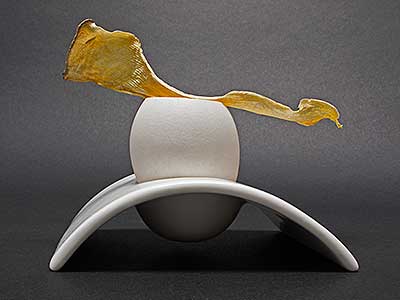March 11, 2013
Amuse-Bouche

poulet et le jaune d’œuf
(chicken and egg yolk)
In my fifty years of cooking I have mastered many techniques. Topping eggs is not one of them. When I walked into La Folie in San Francisco to stage for a couple of weeks, topping eggs was the first task given me. I never got good at it. I noticed that other workers didn’t seem to do any better. Maybe it’s a task that cannot be mastered?
The technique removes a perfect circle from the fat end of the shell of a raw egg. The shell is cleaned out and used as a dish. On my first day, four different workers showed me how to use the topping device, and each had a different method. None worked all that well.
To use the device, you hold the metal cup against the fat end of the egg. You then pull back the spring-loaded plunger and let it go. The edge of the cup puts a circular crack around the shell, which you carefully pick off. At least that’s how it works in theory.
Egg shells vary from egg to egg. Not all are perfectly round. Even though you hold the metal cup tight against the shell, it often bounces a little when the plunger is released. This leaves you with a double crack. If you pull the plunger too far back, the shell is shattered. Pull it back not far enough, and the crack is incomplete. Even with a perfect crack, the egg shell may not break evenly.
I picked up my egg own topping device in France many years ago. We had used the same type in one of the restaurants I worked in, and I wanted one for myself. It cost about $30, and although the package looked like a typical consumer package, there was no manufacturer’s name on it or the device. The one I used at La Folie looked the same. I notice that two additional versions are now available, one from Rösle and one from Pademo World Cuisine. I haven’t used either of these, but they are a lot less expensive than the one I have, should I wish to replace it.
Once you’ve produced the crack, you carefully peel the circular piece of shell away leaving the interior of the egg exposed. On some eggs, the two membranes that line the shell will come off with the shell. On others, they won’t. If the membranes are still intact, carefully tear them. Then dump the contents of the egg into a bowl. You want the yolk to remain intact. At the restaurant, we would top seventy to eighty eggs at a time, and all the contents were dumped into a single, large Cambro. The yolks would be fished out when needed.
The shells would be placed in another Cambro full of very hot water. The hot water made it easier to peel the two membranes away from the inside of the shell. Once they were gone, the empty shell was placed upside-down on the cardboard egg flat. When dry, the shell was righted and a tablespoon of thick soup was placed in the shell. This was followed by a yolk.
When an order came in for the amuse-bouche, the filled shell was placed in a saucepan with simmering water. Inside the saucepan was the cardboard egg flat that was trimmed to sit flat. About ten eggs, supported by the cardboard, could be cooked at once. Once the yolk was jelly-like, the filled shell was transferred to a special plate designed to hold the egg. A thin, flat potato chip with a small hole in the center was placed over the shell’s opening, and a long chive sprig inserted through the hole. A toasted brioche bâton was served on the side.
The soups enclosed in the shell varied from day to day. They were always very simple. One day I saw the soup being made by pureeing a bag of frozen peas with some cream in a blender. When seasoned and heated, it was actually pretty good.
I decided to make a simple, creamy chicken soup for my presentation of this amuse-bouche. The soup is a rich chicken broth thickened with some starch. I save the egg carton and cut it down to fit my saucepan. I assemble the ensemble just before cooking because I don’t have a good place to store the filled egg shells without them spilling. Once cooked, a little finishing salt is sprinkled on the yolk, and the filled shell is placed on an egg dish. A strip of dehydrated king oyster mushroom is placed on top to use for dipping. A small spoon is also provided to help the guests mix the warm egg yolk with the soup.
© 2013 Peter Hertzmann. All rights reserved.
